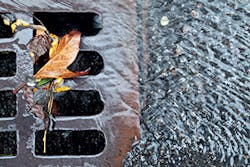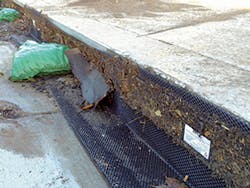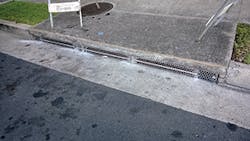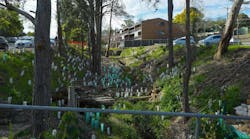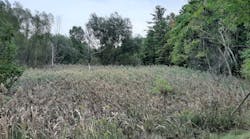As is the case with any active construction site, sediment control is a primary concern on the job sites where Greg McCormick works. He is the water pollution control manager for Riverside Construction Co. in southern California.
Until recently, the company had created protective barriers around storm drain inlets using gravel bags along the gutter at the edge of the pavement. “What happens is that the gravel bags would always get run over, and as an inspector, I’d have to say ‘Fix this.’ Every week I would have to go out to the construction site and say ‘Fix this,'” says McCormick. “With crushed gravel bags, the gravel probably ends up in the gutter, and I’m hoping the guys are picking it up.”
The company recently began using ERTEC Environmental Systems’ Top Guard products for drain inlet protection. McCormick used ERTEC inlet protection products on a job starting in October 2014 on which the company had to shift traffic close to the gutter. In ensuing months, McCormick noted that not only had none of the units been damaged, but they had filled up with sediment to the same degree that check dams would. Capturing sediment is his primary goal with the ERTEC products.
McCormick favors using GR8 Guard for many catch basin and overside drain applications. GR8 Guard is a four-layer system designed to reduce sediment flow into grated storm drain inlets in paved areas. The integrated filter is designed for high flows, with the outer berm allowing water to rise nearly 1.5 inches before reaching the filter, causing heavier particles to settle.
Protecting catch basins and overside drains can be difficult in heavily trafficked areas, but the GR8 Guard doesn’t present a problem for vehicles “because they’re so tucked away as compared to the gravel bags,” he says.
Curb Inlet Guard
captures debris at a
southern California site.
“I use those for catch basins if I do have a grate,” notes McCormick. “Those are the ones that tend to be out in traffic because the drain will pretty much go to the edge of the pavement, so you push the GR8 anywhere from 22 to 26 inches out from the face of the curb. I’ve been using them where there is a swale that runs a couple thousand feet alongside a project and there are three drop inlets; I place one in each of those.”
The GR8 Guard filters stormwater above the ground for ease of visual inspection and maintenance. It is designed for easy installation, longevity, and traffic resistance, and can be reused. The grate does not need to be removed during installation or cleaning.
“I use them specifically to what they’re recommended for, and in my opinion they work really well,” notes McCormick. “The only situation I’ve had is that no matter what kind of inlet protection you use, if there is too much flow, they stop working in the sense that they don’t drain quickly enough to keep water from going out into the traffic.
“These have small holes that help spill into the drain. I’ve had a couple of situations where I’ve had to remove them, and the nice thing is I’m not removing 15 gravel bags, I’m removing two GR8 Guards and flipping them over so they are essentially an L shape on the curb,” he says. “I leave them there and tell my guys to put them back when they’re done. I’m not moving a bunch of bags in the rain.”
On a recent construction job, McCormick chose to use Curb Inlet Guard, Drop Guard, and Combo Guard. Curb Inlet Guard is designed to reduce sedimentation into curb inlets through the use of an integrated filter with a 2-inch vertical height to allow water to bypass during high-flow events. The HDPE units have built-in brackets to keep them from collapsing into the storm drain and can be overlapped as needed to fit all sizes of openings. A hydrocarbon absorption option is available for new asphalt applications. The system is designed to last the life of the project and is UV-stable. It also is designed for ease of installation and cleaning and can be reused.
Drop Guard is designed to reduce sediment flowing into drop inlets on unpaved or soft-scape surfaces. The one-size-fits-all product allows water flow-through but reduces velocity while filtering particles. Drop Guard’s 7-foot recyclable HDPE panels—available in heights of 12 and 15 inches—are trenched to a depth of 4 inches, wrapped around drain inlets, and held together with wood stakes. The filter, designed for concentrated flows, is self-cleaning after post-storm sediment buildup is removed.
Wing-Gate Automatic Retractable Screen in place in Honolulu
Combo Guard is a four-layer system designed to reduce sedimentation into combination curb and grate inlets as part of a comprehensive sediment control approach. The integrated filter’s 2-inch vertical height allows water to bypass during high-flow conditions. The system installs aboveground and is designed for easy installation, visual inspection, and maintenance. Combo Guard is designed to fit most combination storm drains. It is resistant to damage from vehicular traffic. The recyclable HDPE system can be reused.
McCormick says the ERTEC inlet protection products are easy and quick to install. He keeps them in his truck, and when he sees an inlet that needs protection, “I park my truck on the side of the road, open the back, take the two or three I need out, set them down and walk away. I don’t even have to tell the superintendent to fix it, which is awesome because I don’t have to keep telling my guys to pick up crushed gravel bags.”
Riverside Construction Co. gets paid from $150–$250 per inlet to protect it for the life of the job, notes McCormick. That was another factor in choosing ERTEC products. “They cost $50 an inlet, or $100 if there’s two separate guards we have to put in,” says McCormick. “Even so, the guys never have to go back, and labor is $60 an hour.”
He says if he has to do maintenance on the ERTEC products when they get loaded with sediment, he will pick them up and swap them with clean ones he carries in his truck, then go back to the yard where he will beat them with a shovel and wash them down with a hose. His goal is to be able to reuse the products after he removes them from one job and use them on the next.
He also is pleased that he has not been told by any entity for which his company works that the ERTEC inlet protection products are not an approved BMP. “My contracts don’t define how to protect inlets,” he adds. “That leaves it wide open for us as long as I’m demonstrating that I’m capturing sediment—you can’t really quantify it, it’s more visual thing—and they work and the agency sees them.”
McCormick was pleasantly surprised one day when he discovered at a site where there had been a leaky excavator that the ERTEC product was capturing fluid. “These products have ¼-inch felt in them and I could smell the petroleum,” he says. “They were inadvertently capturing hydraulic fluid or oil. A gravel bag would do the same, so it worked in that way as well.”
McCormick uses the ERTEC products in conjunction with other BMPs such as check dams and a “reduced” version of a gravel bag upstream to provide an effective pretreatment BMP.
Keeping Honolulu Beautiful
Concerns about protecting inlets and storm drains don’t stop when construction stops.
To help meet Honolulu’s stormwater management goals, the engineering firm Oceanit—an engineering and technology firm in Hawaii—contacted Terry Flury of United Storm Water in October 2014 to ascertain how his company’s Wing-Gate Automatic Retractable Screen (ARS) might help.
The Wing-Gate ARS opens horizontally like a door, notes Flury, the system’s inventor. “It’s flow directional; that means when water comes down one side of the curb, this device opens up. It pivots from where the flow is coming from.”
The device is constructed of stainless steel with three-quarter-inch perforated holes for a 51% surface opening.
Mounted at the center of the curb drain opening, the Wing-Gate ARS is installed with a 1- to 2-inch gap at the top of the screen for overflow bypass. It remains in a closed position during the dry season or low water flow, and the retained pollutants can be removed using routine street sweeping.
“It remains closed under a stainless steel torsion spring that keeps the street sweepers from pushing debris into the curb openings, so it’s not locked to the curb,” says Flury. “It’s free to open, but the street sweepers pushing debris by it will not open it up.”
During periods of heavy water flow, the spring-activated wings open laterally to prevent flooding that may otherwise be caused by accumulated debris on the screen. The wings close automatically as a storm subsides.
The Wing-Gate ARS is set to open at about 3 inches of curb water flow. “It opens up at one end under spring pressure, which is about 2.5 pounds of pressure on the face of the screen itself,” says Flury. “It will only open up as much as the flow, so if the flow is minimal, it’s not going to open up much.”
During a significant weather event, the ARS will open up as much as needed to accommodate debris such as large palm fronds or whatever is coming down the curb opening, says Flury. “It can actually push the screen opening even further to allow everything in so it doesn’t clog up the front, and it allows the water to drain.
“The ARS device keeps the big stuff from going through, and there are other devices that keep the smaller items such as a cigarette butt from entering the storm drain,” says Flury. “In essence, ARS works like a construction barrier because it keeps out everything from flowing into the catch basin.”
Wings can be manually pinned in the open position as needed during catch basin cleaning or extreme storm conditions. Gates with double or single wings can be installed in series based on catch basin length and flows to the site. The ARS can be used in conjunction with various other storm drain filters.
The Wing-Gate ARS is designed to be “very efficient” when there is trash in front of it, adds Flury. “The whole idea is to keep debris from entering the catch basin,” says Flury. “During a big storm or rain event—especially a big first-flush event—it’s absolutely 100% necessary that the screen opens up and lets everything in. Otherwise it’s going to cause some pretty bad street flooding and lead to some liability issues like you would not believe.”
Honolulu’s storm drain system was presenting some issues that required mitigation, notes Flury.
“They wanted to keep their oceans beautiful, and because there are so many trees and leaves, they had a tremendous problem with their catch basins being impacted with a large amount of green waste,” says Flury.
“Some of the lateral pipes they have that collect from drain to drain were too small,” he adds. “They would clog up very easily, backfill with water, and initially cause a lot of flooding. They wanted to make sure they eliminated their flooding events, and they also wanted to clean up the trash and keep it from entering the ocean.”
Flury says he was at first hesitant about putting anything in the curb openings because the height of curb openings in the state of Hawaii range from 5–6 inches, “which is very small compared to what we have in California. If you put anything of this type in curb openings that small, you risk the chance of street flooding if any debris gets caught in front.”
United Storm Water developed a screen to work for Hawaii’s needs after Oceanit asked the company to pilot test seven Wing-Gate ARS in the streets of Salt Lake, a suburb of Honolulu. The city tested them by opening a fire hydrant to make sure they would open up during a big storm. The screens passed the test.
A subsequent severe weather event with torrential downpours provided a “reality check,” says Flury, with the ARS system performing as designed, opening up and not allowing the streets to be flooded.
In March, Honolulu awarded United Storm Water a contract to retrofit inlets with 400 ARS units. The work will take place in the fall.
“This design was implemented to keep trash from entering the basin; it’s primarily devised to keep the street sweepers picking up all of the trash instead of pushing it into the curb openings,” says Flury. “That’s why the screen was developed in the first place.”
Having the screens in front of the basin, rather than using devices to trap debris within the basin, reduces catch basin cleanouts by about 50% per year, says Flury. Cities typically clean out catch basins three or four times a year to prevent flooding during a significant storm, he adds.
“With the ARS devices in place, you’re looking at the very maximum of two times per year,” he says, adding that while it cuts maintenance costs, it also enables street sweepers to work more efficiently by picking up more debris as opposed to pushing it into the basin.
Flury says he was led to invent the Wing-Gate ARS because he saw that when existing devices opened vertically, “they seemed to work really well when there was no trash involved. The minute trash became a factor, these devices plugged up and liability issues came into effect; streets would flood.”
Although there are different versions of screens on the market, “nobody thought about the idea of a flow-directional type of system that would open up more like a door, which is more efficient because it can open a tremendous amount and really be able to clear large volumes of water and trash and at the same time have the ability to close up and keep debris out during the non-rain events,” he adds.
United Storm Water performs the system installation.
“They have to be put in just right and calibrated,” says Flury. “In order to have a warranty on these items, we have to do it ourselves to be able to back up that warranty.” The warranty is one year for parts and three years for a working system.
There are instances in which the ARS should not be used, points out Flury. “Usually we won’t put anything in that’s 3 inches or less,” he says. “Things can plug up quickly. If a city only does street sweeping once a month, that’s not going to do it. That’s going to cause a problem.”
